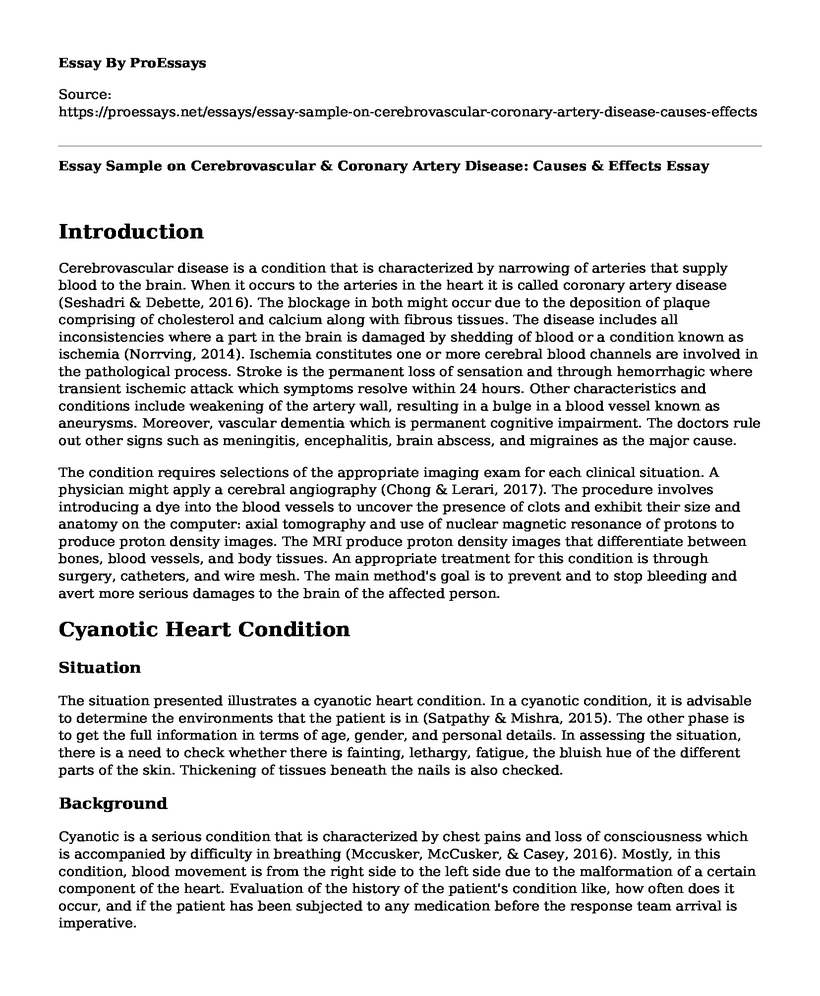Introduction
Cerebrovascular disease is a condition that is characterized by narrowing of arteries that supply blood to the brain. When it occurs to the arteries in the heart it is called coronary artery disease (Seshadri & Debette, 2016). The blockage in both might occur due to the deposition of plaque comprising of cholesterol and calcium along with fibrous tissues. The disease includes all inconsistencies where a part in the brain is damaged by shedding of blood or a condition known as ischemia (Norrving, 2014). Ischemia constitutes one or more cerebral blood channels are involved in the pathological process. Stroke is the permanent loss of sensation and through hemorrhagic where transient ischemic attack which symptoms resolve within 24 hours. Other characteristics and conditions include weakening of the artery wall, resulting in a bulge in a blood vessel known as aneurysms. Moreover, vascular dementia which is permanent cognitive impairment. The doctors rule out other signs such as meningitis, encephalitis, brain abscess, and migraines as the major cause.
The condition requires selections of the appropriate imaging exam for each clinical situation. A physician might apply a cerebral angiography (Chong & Lerari, 2017). The procedure involves introducing a dye into the blood vessels to uncover the presence of clots and exhibit their size and anatomy on the computer: axial tomography and use of nuclear magnetic resonance of protons to produce proton density images. The MRI produce proton density images that differentiate between bones, blood vessels, and body tissues. An appropriate treatment for this condition is through surgery, catheters, and wire mesh. The main method's goal is to prevent and to stop bleeding and avert more serious damages to the brain of the affected person.
Cyanotic Heart Condition
Situation
The situation presented illustrates a cyanotic heart condition. In a cyanotic condition, it is advisable to determine the environments that the patient is in (Satpathy & Mishra, 2015). The other phase is to get the full information in terms of age, gender, and personal details. In assessing the situation, there is a need to check whether there is fainting, lethargy, fatigue, the bluish hue of the different parts of the skin. Thickening of tissues beneath the nails is also checked.
Background
Cyanotic is a serious condition that is characterized by chest pains and loss of consciousness which is accompanied by difficulty in breathing (Mccusker, McCusker, & Casey, 2016). Mostly, in this condition, blood movement is from the right side to the left side due to the malformation of a certain component of the heart. Evaluation of the history of the patient's condition like, how often does it occur, and if the patient has been subjected to any medication before the response team arrival is imperative.
Assessment
Oxygen therapy might be the first action and warming up of the affected areas then, test the blood pressure and the oxygen levels of the blood. It could be carried out through blood draws and pulse oximeters. A complete blood test helps verify the type of cyanotic heart disease present. Cardiovascular catheterization is performed to place a small tube from the groin into the right or left valve of the heart as well as the application of MRI.
Recommendation
After evaluating the type of cyanotic defects, in a case where it might be severe and won't heal in time, open heart surgery might be performed. During the patients' recovery process, it is advisable for the patient to live a stress-free life, quitting any unhealthy lifestyles such as smoking and drinking. Regular check-ups are vital until the disease is eliminated in the blood of the victim.
References
Chong, J. Y., & Lerari, M. P. (2017). Cerebrovascular disease. New York: Oxford University Press.
Mccusker, C., McCusker, C., & Casey, F. (2016). Congenital heart disease and neurodevelopment: Understanding and improving outcomes. London: Elsevier Academic Press.
Norrving, B. (2014). Oxford textbook of stroke and cerebrovascular disease. Oxford: Oxford University Press.
Satpathy, M., & Mishra, B. R. (2015). Clinical diagnosis of congenital heart disease. New Delhi: Jaypee/The Health Sciences Publisher.
Seshadri, S., & Debette, S. (2016). Risk factors for cerebrovascular disease and stroke. New York: Oxford University Press.
Cite this page
Essay Sample on Cerebrovascular & Coronary Artery Disease: Causes & Effects. (2023, Feb 11). Retrieved from https://proessays.net/essays/essay-sample-on-cerebrovascular-coronary-artery-disease-causes-effects
If you are the original author of this essay and no longer wish to have it published on the ProEssays website, please click below to request its removal:
- Personal Nursing Philosophy
- Quality and Safety Issues Concerning SAID the med' Project
- Nursing Workforce Aging Rate Essay Outline
- Cultural and Spiritual Competence of Health Facilities Essay
- PICOT Question and Its Significance in Nursing Practice Paper Example
- Essay Sample on HIM & HIT: Enhancing Quality of Care Through Data Use
- Essay on Hematologist-Family Nurse Practitioner Collaboration: A Must-Have Skill







